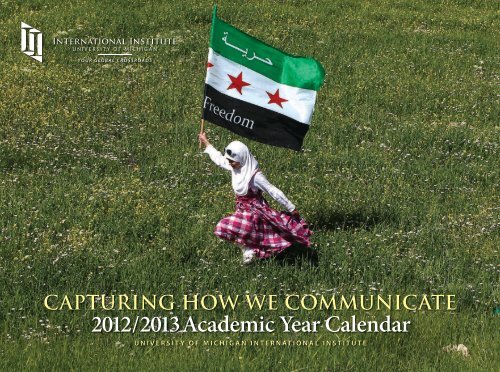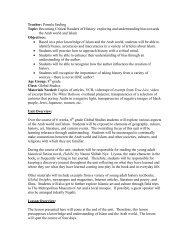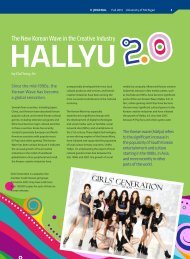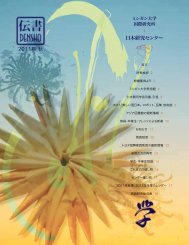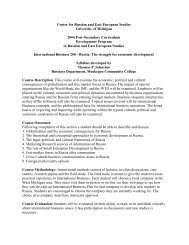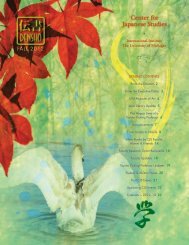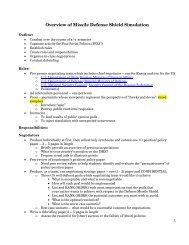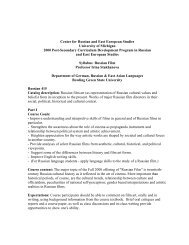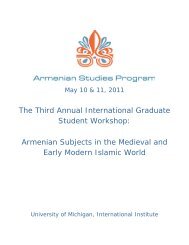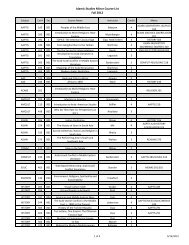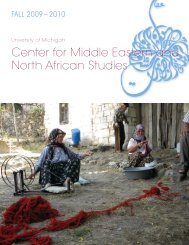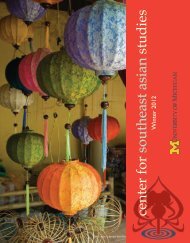2012/2013 Academic Year Calendar - International Institute ...
2012/2013 Academic Year Calendar - International Institute ...
2012/2013 Academic Year Calendar - International Institute ...
You also want an ePaper? Increase the reach of your titles
YUMPU automatically turns print PDFs into web optimized ePapers that Google loves.
CAPTURING HOW WE COMMUNICATE<br />
<strong>2012</strong>/<strong>2013</strong> <strong>Academic</strong> <strong>Year</strong> <strong>Calendar</strong><br />
UNIVERSITY OF MICHIGAN INTERNATIONAL INSTITUTE
CAPTURING HOW<br />
WE COMMUNICATE<br />
Since our earliest history, people have found ways to communicate—through drawings left on the walls of caves,<br />
on clay tablets with cuneiform script, and through Egyptian hieroglyphs written on papyrus, the ancient<br />
forerunner to paper.<br />
The ease with which we transmit language today through modern-day writing systems and technology often<br />
causes us to overlook the fact that communication, historically, has been challenging. Although speech and<br />
body language have long been part of our verbal and nonverbal repertoire, other elements, such as writing, have<br />
evolved much more slowly over time and so have our modes of transmission.<br />
Today, the way we send and receive messages seems almost endless—we call a friend on our cell phone, post a<br />
message on Facebook, send a text, read a magazine, go to the movies, or watch our favorite music video on YouTube.<br />
This calendar attempts to capture the many aspects of how people communicate all over the world through verbal,<br />
nonverbal, written, electronic, and artistic means.<br />
UNIVERSITY OF MICHIGAN INTERNATIONAL INSTITUTE<br />
Established within the College of Literature, Science, and the Arts in 1993, the University of<br />
Michigan <strong>International</strong> <strong>Institute</strong> and its 17 centers and programs stimulate research and teaching on<br />
critical areas of the world and on international issues that cut across world regions and disciplines.<br />
The institute fosters cooperation among the university’s departments, schools, and colleges.<br />
PHOTOS L TO R: CC BY 2.0, ARMENIA, DETAIL OF A MANUSCRIPT, RETLAW SNELLAC; ANDREW SACKS; CC BY 2.0, BOOKS, SHUTTERHACKS; ANDREW SACKS; CC BY 2.0,<br />
FLIPBOARD, JOHAN LARSSON<br />
On the Cover, COVER IMAGE: REUTERS/ALI JAREKJI<br />
UN Security Council Issues Statement<br />
Communicating through opposition<br />
On March 21, <strong>2012</strong>, the UN Security Council issued<br />
a presidential statement backing a plan outlined by<br />
former UN Secretary-General Kofi Annan. It called on<br />
the Syrian government to stop killing civilians, engage<br />
in talks with the opposition, withdraw forces from the<br />
streets, and begin a transition to a democratic political<br />
system. Russia and China, which had previously vetoed<br />
resolutions condemning Syrian President Assad, endorsed<br />
the document. Assad accepted the statement and<br />
agreed to a cease-fire. He later said he would withdraw<br />
troops from cities by April 10. This image shows a young<br />
refugee running with a Syrian opposition flag during a<br />
demonstration against President Bashar al-Assad outside<br />
the Syrian embassy in Amman<br />
on April 13, <strong>2012</strong>.<br />
DID YOU<br />
KNOW?<br />
• Syrian Presidential Election. Former Syrian President<br />
Hafiz Al-Assad died on June 10, 2000, after 30 years<br />
in power. Immediately following his death, the<br />
Parliament amended the constitution, reducing the<br />
mandatory minimum age of the president from 40<br />
to 34 years old. This allowed his son, Bashar Al-Assad<br />
legally to be eligible for nomination by the ruling<br />
Ba'ath party. He was elected president one month<br />
later. Era 8, 20th century since 1945<br />
• Semitic Empire. Archaeologists have demonstrated<br />
that Syria was the center of one of the most ancient<br />
civilizations on earth. Discovered in 1975, the city of<br />
Ebla in northern Syria had a population estimated at<br />
260,000. A great Semitic empire spread from the Red<br />
Sea north to Turkey and east to Mesopotamia from<br />
2500 to 2400 BCE. Eras 1–3, beginnings to 650 CE/AD
RESOURCES<br />
FOR EDUCATORS<br />
www.ii.umich.edu/resources/foreducators<br />
We offer free resources on world regions—many<br />
designed especially for Michigan’s K–14 community:<br />
• Experiential teaching kits<br />
• Educational newspaper supplements<br />
• Lesson plans<br />
• Curriculum development tools<br />
• Information on cultural performers for school visits<br />
• Free on-campus public programs<br />
• Monthly e-newsletter<br />
The centers of the <strong>International</strong> <strong>Institute</strong> offer K–14<br />
educational programs created to help teachers<br />
enhance their curriculums. The centers can bring the<br />
world to your classroom through teacher workshops,<br />
state and national conferences, curriculum<br />
development, lesson planning, in-school presentations,<br />
campus-community partnerships, and one-on-one<br />
consultations.<br />
ELIZABETH REED YARINA<br />
WORLD HISTORY INITIATIVE<br />
The World History Initiative (WHI) is an innovative teacher-training project<br />
and partnership among the University of Michigan's National Resource<br />
Centers and several other U-M units, including the African Studies Center,<br />
School of Education, and Eisenberg <strong>Institute</strong> for Historical Studies. WHI<br />
provides professional development for educators in Michigan teaching a<br />
required, state-mandated sequence in World History and Geography.<br />
Combining pedagogical approaches and content presentations,<br />
WHI brings together university faculty experts from all major world<br />
regions. Faculty members give project-specific presentations tailored<br />
to match both the themes chosen for each historical era being<br />
covered and the content expectations of the new state standards.<br />
Teachers are asked to participate in five-month and one-year surveys<br />
communicating how they have integrated the workshops into their classrooms, shared the experience<br />
with their colleagues, and created materials utilizing WHI materials and/or presentations.<br />
Teacher participants have praised the workshops for both their intellectual content and approach to teaching<br />
world history.<br />
For more information regarding upcoming WHI professional development opportunities, please contact<br />
worldhistory@umich.edu or visit www.ii.umich.edu/resources/fork14educators/worldhistoryinitiative.<br />
LUNAR CALENDAR KEY<br />
New Moon<br />
Full Moon<br />
* Holidays marked with an asterisk are<br />
calculated according to the lunar calendar.<br />
Jewish and Islamic holidays begin at sunset<br />
the evening before the date listed.<br />
CC BY 2.0, TAJ MAHAL, CHRISTOPHER JOHN SSF<br />
WHAT ARE ERAS?<br />
The eras included in the “Did You Know?” facts are part of the<br />
Michigan Department of Education’s Social Studies Framework.<br />
The eras represent historical periods of time that are designed to<br />
help students investigate global patterns and developments and<br />
make comparisons to other regions, societies, and cultures across<br />
time and space. For an overview of these time periods, see the<br />
World History and Geography chart.
CC BY-NC-ND 2.0, ABC, NADINE
AUGUST <strong>2012</strong><br />
Translation for days: Armenian<br />
SUNDAY<br />
kiraki<br />
5<br />
12<br />
19<br />
26<br />
MONDAY<br />
erkushabt‘i<br />
6<br />
13<br />
20<br />
27<br />
TUESDAY<br />
erek‘shabt‘i<br />
7<br />
14<br />
Independence Day<br />
PAKISTAN<br />
21<br />
28<br />
Eid al-Fitr* – Festival of<br />
Fast-Breaking<br />
Celebrates the end<br />
of Ramadan<br />
WEDNESDAY<br />
chorek‘shabt‘i<br />
1<br />
8<br />
15<br />
Independence Day<br />
INDIA<br />
22<br />
29<br />
THURSDAY<br />
hingshabt‘i<br />
2<br />
9<br />
16<br />
23<br />
30<br />
FRIDAY<br />
urbat‘<br />
3<br />
10<br />
17<br />
24<br />
31<br />
SATURDAY<br />
shabat‘<br />
4<br />
11<br />
18<br />
25<br />
ABC<br />
Communicating through the written word<br />
Letters of the Armenian alphabet dominate the exhibit<br />
of Armenian books at the 24th <strong>International</strong> Fair for<br />
books and press in Geneva in May 2010. The Armenian<br />
alphabet was created in 405 CE and was immediately<br />
used to translate philosophical, scientific, historical, and<br />
religious writings from Greek and Syriac into Armenian.<br />
The year <strong>2012</strong> marks the 500th anniversary of the<br />
printing of the first Armenian book Urbatagirk or Friday<br />
Book in Venice. During Geneva’s 26th <strong>International</strong> Fair<br />
for books and press, the Armenian capital of Yerevan<br />
was represented as the World Book Capital <strong>2012</strong>, a<br />
selection made by the United Nations Educational,<br />
Scientific and Cultural Organization (UNESCO). Yerevan<br />
is the 12th capital to have this distinction.<br />
DID YOU<br />
KNOW?<br />
• Leather Shoe. The world’s oldest leather shoe was<br />
found in Armenia during an archaeological dig in<br />
a cave in 2010. The relatively small shoe is approximately<br />
a U.S. women’s size 7. It was made from a single<br />
piece of cowhide, customized to the wearer's foot.<br />
Archaeologists estimate it is 5,500 years old.<br />
Era 8, 20th century since 1945<br />
• Garni Temple. The royal bathhouse of Garni Temple<br />
in Armenia was built in the third century CE. The main<br />
room, with a mosaic floor portraying mythological<br />
figures, served as a dressing room. The floors of the<br />
other three rooms were faced with baked bricks<br />
covered with a layer of polished stucco and were<br />
heated from below with hot air and smoke.<br />
Eras 1–3, beginnings to 650 CE/AD
MOLLIE HANSEN, 2010 ALUMNA, DETROIT COUNTRY DAY SCHOOL
SEPTEMBER <strong>2012</strong><br />
Translation for days: Japanese<br />
Moon<br />
Festival*<br />
CHINA<br />
2<br />
9<br />
16<br />
23<br />
Chuseok/Hangawi* –<br />
Harvest Festival<br />
SOUTH KOREA/<br />
NORTH KOREA<br />
30<br />
SUNDAY<br />
MONDAY<br />
Labor Day<br />
UNITED STATES<br />
3<br />
10<br />
17<br />
Rosh Hashanah* –<br />
Jewish New <strong>Year</strong> begins<br />
Keirō no hi – Respect<br />
for the Aged Day<br />
JAPAN<br />
24<br />
TUESDAY<br />
4<br />
11<br />
18<br />
Rosh Hashanah – Jewish<br />
New <strong>Year</strong> ends<br />
25<br />
WEDNESDAY<br />
Ganesh Chaturthi<br />
INDIA<br />
5<br />
12<br />
19<br />
26<br />
Yom Kippur* – Jewish<br />
Day of Atonement<br />
THURSDAY<br />
Liberation Day<br />
TIMOR-LESTE<br />
6<br />
13<br />
20<br />
27<br />
FRIDAY<br />
7<br />
14<br />
21<br />
Independence Day<br />
ARMENIA<br />
28<br />
SATURDAY<br />
1<br />
8<br />
15<br />
22<br />
29<br />
Worlds Between Us<br />
Communicating through calligraphy<br />
Students from Kousen High School in Kusatsu, Japan,<br />
practice the traditional art of shodō , Japanese<br />
calligraphy. Learning to write kanji , Chinese<br />
characters, is a gradual process. In elementary and<br />
junior high school, students learn to write characters<br />
correctly, beginning first with a soft pencil and<br />
then graduating to brush and ink. During this time,<br />
students also learn about the origin of characters and<br />
the correct stroke order. In high school, shodō is, in<br />
most cases, an elective subject in the arts, aimed at<br />
cultivating students’ artistic sensibilities and powers of<br />
self-expression.<br />
DID YOU<br />
KNOW?<br />
• A Blogging Culture. According to an article in the<br />
Washington Post, Japan has the largest and most<br />
active blogging culture in the world. Research<br />
conducted between 2007 and 2009 indicates that<br />
40% of Japanese blogging is done on cell phones,<br />
and 37% of the world's blog posts are in Japanese.<br />
Compared to their Americans counterparts, Japanese<br />
tend to write shorter posts, anonymously, and more<br />
often. Era 8, 20th century since 1945<br />
• Plaza TV. Television viewing gained popularity in<br />
Japan in the 1950s when Nippon Television placed<br />
TV sets in public places in order to increase the<br />
number of viewers. Until the early 1960s, American<br />
programming formed the bulk of broadcasting. In<br />
1965, Japanese networks began to develop their own<br />
programming. Today, the “plaza TV” phenomenon<br />
continues to be a prominent feature of downtown<br />
areas. Era 8, 20th century since 1945
CEDARBOUGH T. SAEJI (Pungmul Pan-gut performed by the Folk Music Ensemble of the National Gugak Center)
OCTOBER <strong>2012</strong><br />
Translation for days: Korean<br />
SUNDAY<br />
il-yo-il<br />
7<br />
14<br />
21<br />
28<br />
MONDAY<br />
wol-yo-il<br />
Columbus Day<br />
UNITED STATES<br />
1<br />
8<br />
15<br />
22<br />
29<br />
TUESDAY<br />
hwa-yo-il<br />
2<br />
9<br />
16<br />
23<br />
30<br />
WEDNESDAY<br />
su-yo-il<br />
Gandhi Jayanti –<br />
Ghandi’s birthday<br />
INDIA<br />
<strong>International</strong> Day of<br />
Non-Violence German Unification Day<br />
Hangeul Day – Korean<br />
Alphabet Day<br />
SOUTH KOREA<br />
Dashain Festival* begins<br />
celebrates victory of<br />
Goddess Durga over the<br />
demon Mahisasur<br />
NEPAL<br />
3<br />
10<br />
17<br />
24<br />
Dashain Festival ends<br />
Halloween<br />
UNITED STATES<br />
31<br />
THURSDAY<br />
mog-yo-il<br />
4<br />
11<br />
18<br />
25<br />
FRIDAY<br />
geum-yo-il<br />
5<br />
12<br />
19<br />
26<br />
Eid al-Adha* – Festival<br />
of Sacrifice<br />
SATURDAY<br />
to-yo-il<br />
6<br />
13<br />
20<br />
27<br />
Pungmul Pan-gut<br />
Communicating through performance<br />
The National Gugak Center of South Korea hosts a<br />
resident Namsadang team seen here performing Pan-gut,<br />
a traditional Korean dance. Namsadang were traveling<br />
entertainers who presented various acts including a<br />
mask-dance drama, puppet play, bowl spinning, tightrope<br />
walking, acrobatics and pungmul-style drumming and<br />
dancing. They were particularly active near the end of the<br />
Joseon Dynasty, which ruled from 1392–1910. Usually<br />
the finale of the Namsadang performance would be a<br />
pungmul pan-gut. As the drumming sped up, the dancers<br />
would move faster, and audience members, unable to<br />
contain themselves, would rise up and join the fun.<br />
DID YOU<br />
KNOW?<br />
• Prioritizing Education. Koreans place a great deal<br />
of importance on education. Ninety-seven percent of<br />
South Koreans between the ages of 25 and 34 have<br />
completed upper secondary education, making it<br />
the highest percentage in the world according to<br />
the Organisation for Economic Co-operation and<br />
Development. On average, South Korean households<br />
spend 7.5% of their total income on educational<br />
expenses. Era 8, 20th century since 1945<br />
• Hangeul. The Korean writing system, Hangeul ( ),<br />
was published by King Sejong the Great in 1446.<br />
Before this time, Koreans wrote records in Chinese.<br />
Since writing required learning a new language, it<br />
was inaccessible to all but the elite. Hangeul was<br />
created to increase literacy among the common<br />
people. It is the first writing system to be designed<br />
from methodically researched scientific and<br />
philosophical principals and is praised by modern<br />
experts for its systematic classification of the sounds<br />
of the Korean language. Era 5, 15th to 18th centuries
CC BY-NC-ND 2.0, BR-TL002 WORLD BANK, BARBARA RATUSZNIK/WORLD BANK PHOTO COLLECTION
NOVEMBER <strong>2012</strong><br />
Translation for days: Tatum<br />
SUNDAY<br />
domingu<br />
Daylight Saving<br />
Time ends<br />
4<br />
11<br />
Veterans Day<br />
UNITED STATES<br />
St. Martin’s Day<br />
AUSTRIA & GERMANY<br />
18<br />
25<br />
MONDAY<br />
segunda<br />
5<br />
12<br />
Veterans Day Observed<br />
UNITED STATES<br />
19<br />
26<br />
TUESDAY<br />
tersa<br />
Election Day<br />
UNITED STATES<br />
6<br />
13<br />
20<br />
27<br />
WEDNESDAY<br />
kuarta<br />
7<br />
14<br />
21<br />
28<br />
THURSDAY<br />
kinta<br />
All Saints’ Day<br />
Al-Hirja* – Islamic<br />
New <strong>Year</strong><br />
Thanksgiving Day<br />
UNITED STATES<br />
1<br />
8<br />
15<br />
22<br />
29<br />
FRIDAY<br />
sesta<br />
2<br />
9<br />
16<br />
23<br />
30<br />
SATURDAY<br />
sabtu<br />
3<br />
10<br />
17<br />
24<br />
Ashura* – 10th day of<br />
the Islamic New <strong>Year</strong><br />
a day of mourning in<br />
Shi’a Islam<br />
School Girls in Oecusse, Timor-Leste<br />
Communicating through education<br />
Because of intermittent and severe violence from 1975<br />
to 1999, education for all Timor-Leste’s children has been<br />
disrupted. Now, only 59% of the adult population is literate,<br />
and the average length of schooling is 11 years. Women<br />
are less likely than men to be literate, and girls are less<br />
likely than boys to be enrolled in school. Since the end of<br />
violence in 2002, access to education has improved for all.<br />
DID YOU<br />
KNOW?<br />
• Timor-Leste Declares Independence. Colonized<br />
since the 16th century, Timor-Leste declared its<br />
independence from Portugal in 1975. Nine days<br />
later, it was invaded and taken over by Indonesia.<br />
A campaign for independence followed until 1999<br />
when the population voted for independence from<br />
Indonesia in a UN-supervised election. Much of the<br />
country was destroyed by the warfare before and<br />
after the referendum. Era 8, 20th century since 1945<br />
• Trade Routes. Timor-Leste was part of Chinese and<br />
Indian trading routes as early as the 14th century. At<br />
that time, it was an important source of sandalwood,<br />
honey, and wax. Era 4, 300–1500 CE/AD
NINA BHATTACHARYA, BA, INTERNATIONAL AND COMPARATIVE STUDIES, <strong>2012</strong>
DECEMBER <strong>2012</strong><br />
Translation for days: Hindi<br />
SUNDAY<br />
ravivar<br />
Chanukah begins<br />
Chanukah ends<br />
2<br />
9<br />
16<br />
23<br />
30 31<br />
MONDAY<br />
somavar<br />
Christmas<br />
Eve<br />
3<br />
10<br />
17<br />
24<br />
TUESDAY<br />
mangalavar<br />
Christmas Day<br />
4<br />
11<br />
18<br />
25<br />
WEDNESDAY<br />
budhavar<br />
Kwanzaa begins<br />
5<br />
12<br />
19<br />
26<br />
THURSDAY<br />
guruvar<br />
6<br />
13<br />
20<br />
27<br />
FRIDAY<br />
shukravar<br />
Winter Solstice<br />
7<br />
14<br />
21<br />
28<br />
SATURDAY<br />
shanivar<br />
1<br />
8<br />
15<br />
22<br />
29<br />
Active, Engaged Empowerment<br />
Communicating through financial training<br />
A worker from the Chinmaya Organization for Rural<br />
Development (CORD), dressed in purple, sits down with<br />
a village microfinance group to make sure it is on track.<br />
Through these groups, women can access necessary<br />
credit to support their families and start businesses.<br />
A majority of the communication is done in the local<br />
dialect, Pahadi, to allow the women to take maximum<br />
ownership in running the group. They also learn how to<br />
balance their books and keep careful track of the<br />
group’s finances.<br />
DID YOU<br />
KNOW?<br />
• One Country, Many Languages. India has 16 official<br />
languages according to 2001 census data cited in the<br />
CIA World Factbook. Hindi, the national language is<br />
spoken by more than 40% of the population. English<br />
enjoys the status of subsidiary official language and<br />
is important for national, political, and commercial<br />
communication. Era 8, 20th century since 1945<br />
• India Gains Independence. Beginning in 1920,<br />
Indian leader Mohandas K. Gandhi transformed the<br />
Indian National Congress political party into a mass<br />
movement to campaign against British colonial rule.<br />
The party used both parliamentary and nonviolent<br />
resistance to agitate for independence. During this<br />
period, millions of Indians served in the British Indian<br />
Army, including service in both World Wars. On<br />
August 15, 1947, India became a dominion within<br />
the Commonwealth, with Jawaharlal Nehru as prime<br />
minister. Era 7, 1900 to 1945
JOSHUA SHAPERO, PHD CANDIDATE, DEPARTMENT OF ANTHROPOLOGY, UNIVERSITY OF MICHIGAN
JANUARY <strong>2013</strong><br />
Translation for days: Quechua<br />
SUNDAY<br />
intichaw<br />
Christmas<br />
ARMENIA<br />
6<br />
13<br />
20<br />
27<br />
MONDAY<br />
killachaw<br />
7<br />
Orthodox Christmas<br />
14<br />
Seijin no hi – Coming<br />
of Age Day<br />
JAPAN<br />
Martin Luther<br />
King Jr. Day<br />
UNITED STATES<br />
21<br />
28<br />
TUESDAY<br />
atipachaw<br />
New <strong>Year</strong>’s Day<br />
Kwanzaa ends<br />
1<br />
8<br />
15<br />
22<br />
29<br />
WEDNESDAY<br />
quyllurchaw<br />
2<br />
9<br />
16<br />
23<br />
30<br />
THURSDAY<br />
illapachaw<br />
3<br />
10<br />
17<br />
24<br />
31<br />
FRIDAY<br />
chaskachaw<br />
4<br />
11<br />
18<br />
25<br />
SATURDAY<br />
kuychichaw<br />
5<br />
12<br />
19<br />
26<br />
Playing Tag at 12,000 Feet<br />
Communicating through play and games<br />
School children on a field trip to Qitsqay Hirka, the<br />
mountain above their school in Huaripampa, Peru,<br />
are urged to speak only in Quechua as they play<br />
mamallaachi, a game similar to tag. They are the first<br />
class to have graduated from primary school under<br />
the new bilingual intercultural education program. In<br />
response to the fact that Spanish is rapidly replacing<br />
Quechua in many contexts of life in rural communities<br />
like Huaripampa, the bilingual intercultural education<br />
program reinforces the use and value of the indigenous<br />
Quechua language.<br />
DID YOU<br />
KNOW?<br />
• Machu Picchu. Often referred to as the “Lost City<br />
of the Incas,” Machu Picchu is located in the Andes<br />
Mountains in Cusco, Peru. Archeologists believe<br />
Machu Picchu was built in the 1400s as an estate<br />
for the Incan emperor Pachacuti and abandoned a<br />
century later when the Spanish conquered the Incan<br />
empire. Era 4, 300 –1500 CE/AD<br />
• Túpac Amaru II’s Rebellion. José Gabriel Túpac<br />
Amaru II was the leader of an uprising against the<br />
Spanish in Peru in 1780. The rebellion was sparked<br />
by abuses of the indigenous population by local<br />
authorities of the Spanish crown. At its height,<br />
it mobilized more than 6,000 mostly indigenous<br />
insurgents against Spanish troops. Although Túpac<br />
Amaru was later captured and executed, he became<br />
a symbolic figure in the Peruvian struggle for<br />
independence and the indigenous rights movement.<br />
Era 5, 15th to 18th centuries
BENJAMIN BROSE, ASSISTANT PROFESSOR OF CHINESE BUDDHISM, ASIAN LANGUAGES & CULTURES, UNIVERSITY OF MICHIGAN
FEBRUARY <strong>2013</strong><br />
Translation for days: Chinese (Mandarin pronunciation)<br />
SUNDAY<br />
xing qi tian<br />
3<br />
10<br />
Chinese New <strong>Year</strong>* –<br />
<strong>Year</strong> of the Snake<br />
Seollal* – Lunar<br />
New <strong>Year</strong><br />
NORTH KOREA &<br />
SOUTH KOREA<br />
17<br />
24<br />
MONDAY<br />
xing qi yi<br />
Presidents’ Day<br />
UNITED STATES<br />
4<br />
11<br />
18<br />
25<br />
Independence Day<br />
DOMINICAN REPUBLIC<br />
TUESDAY<br />
xing qi er<br />
Carnavales de<br />
Cajamarca ends<br />
PERU<br />
5<br />
12<br />
19<br />
26<br />
WEDNESDAY<br />
xing qi san<br />
Ash Wednesday –<br />
Lent begins<br />
6<br />
13<br />
20<br />
27<br />
THURSDAY<br />
xing qi si<br />
Valentine’s Day<br />
UNITED STATES<br />
7<br />
14<br />
21<br />
28<br />
FRIDAY<br />
xing qi wu<br />
Carnavales de<br />
Cajamarca begins<br />
PERU<br />
1<br />
8<br />
15<br />
22<br />
SATURDAY<br />
xing qi liu<br />
2<br />
9<br />
16<br />
23<br />
Selling Cell Phones: Yangzhou, China<br />
Communicating through technology<br />
A performer draws a crowd of potential customers on a<br />
hot afternoon in Yangzhou. The products are the newest<br />
Nokia cell phones. A couple of years ago, China reported<br />
that there were more than 700 million mobile phone<br />
users—double the total U.S. population! Phone owners<br />
may own multiple phones for different purposes, and<br />
no one can do without. People in China’s rural regions,<br />
for example, find phones essential for conducting their<br />
micro businesses.<br />
DID YOU<br />
KNOW?<br />
• Chinese Information Highway. According to<br />
research on the Chinese blogosphere, there are more<br />
than 450 million users of the Sinophone Internet<br />
who spend more than 40% of their free time in<br />
cyberspace. Instant messaging makes up 77% of the<br />
leading uses by “netizens,” people who frequently use<br />
the Internet. Only music tops this category at 79%.<br />
Values, ideologies, and meaning are transmitted via<br />
the Internet—a highway that is also affected more<br />
and more by political and commercial challenges.<br />
Era 8, 20th century since 1945<br />
• Camel Caravans. One of the most famous routes<br />
for trade was the Silk Road, a network of pathways<br />
linking Asia with Central Asia and Europe. Although<br />
high-speed Internet transmits information today<br />
anywhere in seconds, 1,000 years ago it would have<br />
taken six months via camel caravan to send music<br />
and ideas from Beijing to Samarkand.<br />
Era 4, 300–1500 CE/AD
CC BY-NC-ND 2.0, SDM-NP-097 WORLD BANK, SIMONE D. MCCOURTIE/WORLD BANK PHOTO COLLECTION
MARCH <strong>2013</strong><br />
Translation for days: Nepali<br />
31<br />
SUNDAY<br />
aitobaar<br />
Daylight Saving<br />
Time begins<br />
UNITED STATES<br />
Easter<br />
3<br />
10<br />
17<br />
24<br />
MONDAY<br />
sombaar<br />
Passover* begins<br />
4<br />
11<br />
18<br />
25<br />
TUESDAY<br />
mangalbaar<br />
5<br />
12<br />
19<br />
26<br />
WEDNESDAY<br />
budhabaar<br />
Holi* – Spring<br />
Festival begins<br />
INDIA<br />
6<br />
13<br />
20<br />
27<br />
THURSDAY<br />
bihibaar<br />
7<br />
14<br />
21<br />
Nowruz* – Zoroastrian,<br />
Iranian, & Central<br />
Asian New <strong>Year</strong><br />
UN OBSERVED<br />
Human Rights Day<br />
SOUTH AFRICA<br />
Holi – Spring<br />
Festival ends<br />
INDIA<br />
28<br />
FRIDAY<br />
shukrabaar<br />
Good Friday<br />
1<br />
8<br />
15<br />
22<br />
29<br />
SATURDAY<br />
shanibaar<br />
Holy Saturday –<br />
Lent ends<br />
2<br />
9<br />
16<br />
23<br />
30<br />
A Market Scene in Kaski, Nepal<br />
Communicating through trade<br />
Kaski in western Nepal covers parts of the Annapurna<br />
mountain range, and the picturesque mountains can be<br />
observed from most parts of the area. Pokhara, the main<br />
city in this district, is one of the best tourist destinations<br />
of Nepal. Like many markets in South Asia, Kaski’s market<br />
is busy, colorful, and loud. The sights, sounds, and smells<br />
can quickly lead to sensory overload. It is customary to<br />
bargain for everything from vegetables to used designer<br />
outerwear—which is often sold to shopkeepers by<br />
mountaineers from the West after they return from<br />
their expeditions.<br />
DID YOU<br />
KNOW?<br />
• Summiting Mt. Everest. In 1953 Nepal's Sherpa<br />
Tenzing Norgay and New Zealander Edmund Hillary<br />
took part in John Hunt’s expedition to climb Mt. Everest.<br />
They become the first climbers to reach the summit. It<br />
was Tenzing’s seventh expedition to Everest and his first<br />
successful one. In 1996, his son Jamling Tenzing Norgay<br />
summited Everest also, but Tenzing, who died in 1986 at<br />
the age of 71, did not live to see this. Era 8, 20th century<br />
since 1945<br />
• Birth of the Buddha. In the sixth century BCE, Prince<br />
Siddhartha Gautama was born near Lumbini, Nepal.<br />
When he reached the age of 29 he renounced royal<br />
life and led a life seeking spiritual enlightenment. He<br />
became known as the Buddha. Buddhism continues<br />
to shape the face of Asia, but in Nepal it lost ground<br />
to resurgent Hinduism over the centuries. Nepal<br />
today is the world's only Hindu monarchy.<br />
Eras 1–3, beginnings to 650 CE/AD
CHRISTINE MORRISON, BS, CHEMISTRY, 2010
APRIL <strong>2013</strong><br />
Translation for days: Polish<br />
SUNDAY<br />
niedziela<br />
7<br />
14<br />
21<br />
28<br />
MONDAY<br />
poniedziałek<br />
1<br />
8<br />
Yom Hashoah –<br />
Holocaust<br />
Remembrance Day<br />
15<br />
22<br />
29<br />
TUESDAY<br />
wtorek<br />
Passover ends<br />
2<br />
9<br />
16<br />
23<br />
30<br />
WEDNESDAY<br />
ŚRODA<br />
3<br />
10<br />
17<br />
24<br />
Genocide<br />
Commemoration Day<br />
ARMENIA<br />
THURSDAY<br />
czwartek<br />
4<br />
Clear Brightness<br />
Festival<br />
CHINA<br />
Independence Day<br />
SENEGAL<br />
11<br />
18<br />
25<br />
FRIDAY<br />
piątek<br />
5<br />
12<br />
19<br />
26<br />
SATURDAY<br />
sobota<br />
Freedom Day<br />
SOUTH AFRICA<br />
6<br />
13<br />
20<br />
27<br />
Tradition<br />
Communicating through customs and traditions<br />
It is a Jewish custom to place stones at gravesites to<br />
honor the memory of the deceased. Over a dozen<br />
stones have been laid on the footstep of this train car in<br />
Oświęcim, Poland, honoring the thousands of people<br />
who rode through the entrance gate in the foggy<br />
background to the Nazi concentration camp<br />
Auschwitz-Birkenau.<br />
DID YOU<br />
KNOW?<br />
• Modern Poland. Poland today is an increasingly<br />
prosperous country with strong democratic institutions<br />
and an exciting, diverse cultural life. It is the<br />
fifth largest country in the European Union, which<br />
it joined in 2004. Poland continues to struggle with<br />
issues of economic inequality, with growing cities like<br />
Warsaw, Poznań, and Wrocław contrasting sharply<br />
with the impoverished, mostly rural eastern part of<br />
the country. Era 8, 20th century since 1945<br />
• Holocaust. During World War II, German Nazi forces<br />
invaded Poland, killing six million Poles including<br />
nearly all of the country’s three million Jews. The<br />
targeted killing of Jewish people and others that the<br />
Nazis determined “racially inferior” is known as the<br />
Holocaust. More than one million people were killed<br />
at the concentration camp Auschwitz, which is now a<br />
museum commemorating those who lost their lives.<br />
Era 7, 1900-1945
CHRISTINE MORRISON, BS, CHEMISTRY, 2010
MAY <strong>2013</strong><br />
Translation for days: German<br />
SUNDAY<br />
sonntag<br />
Orthodox Easter<br />
Mother’s Day<br />
UNITED STATES<br />
5<br />
12<br />
19<br />
26<br />
MONDAY<br />
montag<br />
6<br />
13<br />
20<br />
Independence Day<br />
TIMOR-LESTE<br />
Memorial Day<br />
UNITED STATES<br />
27<br />
TUESDAY<br />
dienstag<br />
7<br />
14<br />
21<br />
28<br />
WEDNESDAY<br />
mittwoch<br />
1<br />
8<br />
15<br />
22<br />
29<br />
THURSDAY<br />
donnerstag<br />
Europe Day<br />
EUROPEAN UNION<br />
2<br />
9<br />
16<br />
23<br />
30<br />
FRIDAY<br />
freitag<br />
Constitution Day<br />
POLAND<br />
3<br />
10<br />
17<br />
24<br />
31<br />
SATURDAY<br />
samstag<br />
Midori no hi –<br />
Greenery Day<br />
JAPAN<br />
4<br />
11<br />
18<br />
25<br />
Africa Day<br />
annual commemoration<br />
of the founding of the<br />
Organisation of African Unity,<br />
now the African Union<br />
Buddha Jayanti* –<br />
birth anniversary of<br />
the Buddha<br />
NEPAL<br />
Love Padlocks<br />
Communicating through symbolism<br />
Over the Rhine River in Cologne, Germany, there is<br />
a bridge carrying a lot more metal than train tracks.<br />
Couples, families, and friends come here to attach their<br />
“love padlocks” to the fence as a symbol of everlasting<br />
love. Similar displays can be found in several other<br />
countries throughout the world.<br />
DID YOU<br />
KNOW?<br />
• A Popular Language. German is the most widely<br />
spoken language in Europe. In addition to the<br />
83 million inhabitants of Germany, people speak<br />
German in many other countries including Austria,<br />
Switzerland, Luxembourg, and Liechtenstein,<br />
where it is also an official language. German is<br />
the third-most popular foreign language taught<br />
worldwide and the second-most popular in Europe<br />
and Japan after English. Era 8, 20th century since<br />
1945<br />
• Invention of the Printing Press. Johannes<br />
Gutenberg, a German blacksmith, invented a<br />
movable press that allowed for mass-printing, and<br />
in 1454 he produced the first printed Bible. The<br />
ability to print books with machines rather than<br />
writing manuscripts by hand was key to spreading<br />
knowledge across Europe during the Renaissance<br />
and beyond. Era 4, 300–1500 CE/AD
AMIR SYED, PHD STUDENT, DEPARTMENTS OF ANTHROPOLOGY AND HISTORY, UNIVERSITY OF MICHIGAN
JUNE <strong>2013</strong><br />
Translation for days: Wolof<br />
30<br />
SUNDAY<br />
dibéér<br />
Republic Day<br />
ITALY<br />
Youth Day<br />
SOUTH AFRICA<br />
Father’s Day<br />
UNITED STATES<br />
2<br />
9<br />
16<br />
23<br />
MONDAY<br />
altiné<br />
3<br />
10<br />
17<br />
24<br />
TUESDAY<br />
talaata<br />
4<br />
11<br />
18<br />
25<br />
WEDNESDAY<br />
Àllarba<br />
Russia Day<br />
5<br />
12<br />
19<br />
26<br />
THURSDAY<br />
alxames<br />
6<br />
13<br />
20<br />
27<br />
FRIDAY<br />
Àjjuma<br />
7<br />
14<br />
21<br />
Summer Solstice<br />
Inti Raymi – Festival<br />
of the Sun<br />
Celebrated in indigenous<br />
cultures throughout<br />
the Andes<br />
28<br />
SATURDAY<br />
gawo<br />
1<br />
8<br />
15<br />
22<br />
29<br />
Don’t Touch My Constitution<br />
Communicating through protest<br />
Riots broke out in downtown Dakar, Sengal, on June 23,<br />
2011, in opposition to then President Abdoulaye Wade's<br />
proposed constitutional amendments which would<br />
have nearly guaranteed his re-election by reducing<br />
the proportion of votes needed to win a presidential<br />
election and avoid a runoff from more than 50% to 25%.<br />
He had also wanted to create an elected post of vice<br />
president. The opposition had established a coalition<br />
called “Don't Touch My Constitution,” which became a<br />
central rallying point for the protesters.<br />
DID YOU<br />
KNOW?<br />
• Term Limits. Former President Wade was first elected<br />
in 2000. During his seven-year term, the constitution<br />
was changed to limit a president to two five-year<br />
terms. Re-elected in 2007, he stated that he neither<br />
would nor could under the constitution run again.<br />
He later reasoned that his 2007 win was actually his<br />
first term under the current constitution, freeing him<br />
to run again in <strong>2012</strong>. Senegal's Constitutional Court<br />
agreed with him. Era 8, 20th century since 1945<br />
• Senegalese Independence. Senegal was a French<br />
colony and inherited a legacy of democratic<br />
principles. As evidenced by political forces that<br />
emerged during the 1950s including a strong trade<br />
union movement, Islamic sects, and exponents of<br />
Marxism. In November 1958, Senegal became a<br />
self-governing member of the French Community.<br />
Senegal became an independent state on August 20,<br />
1960, after seceding from the Mali Federation.<br />
Era 8, 20th century since 1945
MEINRAD HECK
JULY <strong>2013</strong><br />
Translation for days: Xhosa<br />
SUNDAY<br />
icawe<br />
Bastille Day<br />
FRANCE<br />
7<br />
14<br />
21<br />
28<br />
Fiestas Patrias –<br />
Independence Day from<br />
the Spanish Empire<br />
PERU<br />
MONDAY<br />
umvulo<br />
1<br />
8<br />
15<br />
22<br />
29<br />
TUESDAY<br />
ulwesibini<br />
Ramadan* begins<br />
2<br />
9<br />
16<br />
23<br />
30<br />
WEDNESDAY<br />
ulwesithathu<br />
3<br />
10<br />
17<br />
24<br />
31<br />
THURSDAY<br />
ulwesine<br />
Independence Day<br />
UNITED STATES<br />
Mandela Day<br />
SOUTH AFRICA<br />
4<br />
11<br />
18<br />
25<br />
FRIDAY<br />
ulwesihlanu<br />
5<br />
12<br />
19<br />
26<br />
SATURDAY<br />
umgqibelo<br />
6<br />
13<br />
20<br />
27<br />
“The Voice”<br />
Communicating through song<br />
Vusi Mahlasela is a musician, singer-songwriter, and<br />
composer from South Africa. Known as “The Voice” in<br />
his country, he is celebrated for his distinct, powerful<br />
voice and his poetic, optimistic lyrics. His songs of<br />
hope connect apartheid-scarred South Africa with its<br />
promise for a better future. Mahlasela performed at the<br />
1994 inauguration of former South African President<br />
Nelson Mandela. He helped ring in the World Cup at<br />
FIFA’s kick-off concert at Orlando Stadium, and his song<br />
“When You Come Back” was ITV’s official theme song<br />
for the World Cup in the United Kingdom. Mahlasela<br />
visited the University of Michigan as a Center for World<br />
Performance Studies Artist Resident in <strong>2012</strong>.<br />
DID YOU<br />
KNOW?<br />
•• Nelson Mandela. On April 27, 1994, the first<br />
democratic elections were held in South Africa with<br />
people of all races being able to vote. A Government<br />
of National Unity was formed with Nelson Mandela<br />
as president. Mandela had spent more than 27 years<br />
in prison for his opposition to apartheid. His release<br />
from prison in February 1990 was the beginning of<br />
the slow dismantling of the apartheid system.<br />
Era 8, 20th century since 1945<br />
• Founding of Cape Town. Dutch traders landed<br />
at the southern tip of modern-day South Africa in<br />
1652 and established a stopover point on the spice<br />
route between the Netherlands and the Far East,<br />
founding the city of Cape Town. The British would<br />
later seize the Cape of Good Hope area in 1806.<br />
Further immigration by European settlers due to<br />
the discovery of diamonds and gold intensified the<br />
subjugation of the native inhabitants. Era 5, 15th to<br />
18th centuries
Michigan Department of Education<br />
High School Social Studies Content Expectations v. 10.07 www.michigan.gov/mde
The African Studies Center serves as a conduit through which the<br />
many African initiatives across the University of Michigan, from law<br />
and medicine to the sciences and humanities, may be furthered to<br />
the mutual benefit of the university and its African partners.<br />
www.ii.umich.edu/asc<br />
The University of Michigan’s Armenian Studies Program promotes<br />
the study of the history, language, and culture of Armenia and of the<br />
Armenian diaspora and prepares new scholars in the field. Through its<br />
work in the United States and abroad, the program strives to contribute<br />
to the scholarly analysis and understanding of the history, culture, and<br />
challenges of the Near East and the Caucasus which Armenians have<br />
been part of for millennia. www.ii.umich.edu/asp<br />
Founded in 1961, the Center for Chinese Studies at the University<br />
of Michigan provides students, specialists, and the public with<br />
expert resources and a deeper understanding of contemporary and<br />
historical issues related to China. www.ii.umich.edu/ccs<br />
The Center for European Studies is the focal point for the<br />
interdisciplinary study of Europe at the University of Michigan. The<br />
center offers multi-disciplinary research, education, and outreach<br />
programs to promote understanding of an integrated Europe at the<br />
university and in the community. www.ii.umich.edu/ces<br />
The Center for <strong>International</strong> and Comparative Studies focuses on<br />
topics of global significance that cut across geographic boundaries<br />
and academic disciplines. Through its programs and partnerships the<br />
center seeks to further multidisciplinary exploration of global issues,<br />
particularly those related to human rights, international development, and<br />
international security and cooperation. www.ii.umich.edu/cics<br />
The Center for Japanese Studies promotes and disseminates<br />
research on Japan, fosters communication among diverse disciplines,<br />
and encourages new approaches in the understanding of Japan and<br />
its place in the world. www.ii.umich.edu/cjs<br />
The Center for Latin American and Caribbean Studies at the<br />
University of Michigan <strong>International</strong> <strong>Institute</strong> advances knowledge<br />
about Latin America and the Caribbean and seeks to heighten<br />
interest in this region among members of the U-M community and<br />
the public. Through collaborative partnerships across the university,<br />
the center fosters teaching and research across a wide range of<br />
disciplines and professional fields. www.ii.umich.edu/lacs<br />
The Center for Middle Eastern and North African Studies<br />
enhances awareness of the peoples, cultures, and languages in the<br />
Middle East and North Africa. This vitally important region of the<br />
world constitutes a highly diverse cultural area now undergoing<br />
rapid and large-scale change. www.ii.umich.edu/cmenas<br />
The Nam Center for Korean Studies encourages economic, political,<br />
and cultural understanding of Korea in the University of Michigan<br />
community and beyond. Through its support of students and faculty as<br />
well as its ambitious public programming, the center seeks to increase<br />
the depth and breadth of resources devoted to Korean studies.<br />
www.ii.umich.edu/ncks<br />
The Center for Russian, East European, and Eurasian Studies at the<br />
University of Michigan is dedicated to advancing and disseminating<br />
interdisciplinary knowledge about the peoples, nations, and cultures<br />
of Russia, Central and Eastern Europe, and Eurasia, past and present.<br />
Through its academic programs and support of area-focused training<br />
and scholarship across U-M’s schools and colleges, CREES helps meet<br />
the nation’s ongoing need for experts with deep contextual knowledge<br />
who are proficient in the region’s languages. www.ii.umich.edu/crees<br />
The Center for South Asian Studies at the University of Michigan<br />
seeks to initiate new cross-disciplinary discussions, promote<br />
scholarly analysis, and encourage a deeper appreciation of this<br />
region. Offering courses, events, and cutting-edge research, it is one<br />
of the largest programs devoted to South Asia in the United States.<br />
www.ii.umich.edu/csas<br />
The Center for Southeast Asian Studies emphasizes learning across<br />
the disciplines in this dynamic and understudied part of the world.<br />
By supporting education at an international, national, and local<br />
level, we seek to integrate Southeast Asia into broader scholarship<br />
and curricula. www.ii.umich.edu/cseas<br />
The Center for World Performance Studies seeks to unite artists,<br />
performers, scholars and the community through the international<br />
language of the arts. The center strives to bridge the gap between<br />
performance and scholarship, increase knowledge of performing<br />
arts around the globe, bring into intellectual focus the increasing<br />
globalization of the performing arts, and take advantage of the<br />
interdisciplinary opportunities at the University of Michigan.<br />
www.ii.umich.edu/cwps
ums<br />
youth<br />
education<br />
program<br />
Learning is core to UMS’s mission, and it is our<br />
joy to provide creative learning experiences<br />
for our entire community. Each season, we<br />
offer a spectrum of education and community<br />
engagement activities focusing on K-12<br />
students, teachers, teens, university students,<br />
families, adults, and cultural communities.<br />
We exist to create a spark in people, young<br />
and old alike, to expose them to things they<br />
haven’t seen before, and leave them with an<br />
ongoing and lifelong passion for creativity and<br />
the performing arts.<br />
The UMS Youth Education program consists<br />
of culturally and artistically diverse daytime<br />
Youth Performances, educator professional<br />
development workshops, in-school visits by<br />
artists, and academically aligned curriculum<br />
resources. Each season serves up to 20,000<br />
youth, parents, and educators in southeastern<br />
Michigan. The program is enhanced by official<br />
partnerships with the Ann Arbor Public<br />
Schools, the Washtenaw Intermediate School<br />
District, and the Kennedy Center Partners in<br />
Education Program.<br />
for<br />
CoMPLETE<br />
InforMATIon<br />
VISIT<br />
www.ums.org/learn<br />
E-MAIL<br />
umsyouth@umich.edu<br />
CALL<br />
734.615.0122<br />
The AnimA ls A nd Children<br />
Took T o T he sTreeT s<br />
<strong>2012</strong>/<strong>2013</strong><br />
YouTh PErforMAnCE SErIES<br />
Suzhou Kun opera Theatre of<br />
Jiangsu Province<br />
Friday, september 28, 11 am<br />
Lydia Mendelssohn Theatre<br />
From Cass Corridor to the World:<br />
a tribute to detroit’s musical golden age<br />
tuesday, January 22, 11 am<br />
Hill Auditorium<br />
Martha Graham Dance Company<br />
Friday, January 25, 11 am<br />
Power Center<br />
Mariachi Vargas de Tecalitlán<br />
monday, January 28, 11 am<br />
Hill Auditorium<br />
The Animals and Children Took<br />
to the Streets<br />
1927<br />
Friday, april 12, 11 am<br />
Performance Network<br />
ragamala Dance:<br />
sacred earth<br />
Wednesday, april 24, 11 am<br />
Power Center<br />
Major program support provided by<br />
Ford Motor Company Fund and<br />
Community Services, The Andrew W.<br />
Mellon Foundation, and The University<br />
of Michigan.<br />
ums unleashes the power of world-class performing arts in order<br />
to engage, educate, transform, and connect individuals with<br />
transcendent experiences.<br />
UMMA offers a unique, intimate experience of<br />
art from around the world and a full calendar<br />
of exciting events and programs<br />
Curriculum-based Tours<br />
UMMA offers a menu of tours that are aligned<br />
with state of Michigan social studies and science<br />
curricula using the visual arts as a focus and<br />
springboard for learning. <strong>Academic</strong>ally enriching<br />
and great fun, docent-led tours enable K–12<br />
students to understand history, culture, geography,<br />
art, and much more. Always free, UMMA’s docent<br />
tours help students develop observation skills and<br />
visual literacy, confidence and critical thinking.<br />
Contact umma-tours@umich.edu to schedule a<br />
tour and to receive bus subsidy information.<br />
Teacher Workshops<br />
UMMA’s teacher workshops include interactive<br />
gallery tours, hands-on art making, and material<br />
for personal and classroom use in a friendly and<br />
relaxed atmosphere. Our upcoming exhibition<br />
Benjamin West: General Wolfe and the Art of<br />
Empire will provide an important opportunity for<br />
exploring art and maps as primary documents<br />
that expand the understanding of history. Look<br />
for the associated teacher workshop this fall. Our<br />
winter teacher workshop will feature the exhibition<br />
El Anatsui: When I Last Wrote to You About Africa.<br />
Anatsui is a contemporary artist from Ghana whose<br />
sublime tapestry-like hangings and works in other<br />
media reference the great political changes in<br />
Africa in the 20th century, as well as environmental<br />
and economic issues. This exhibition is sure to be a<br />
crowd-pleaser so sign up early.<br />
The University of Michigan Museum of Art<br />
525 South State Street, Ann Arbor, Michigan 48109-1354<br />
734.764.0395 | umma.umich.edu<br />
For information on teacher<br />
workshops, tours, and upcoming<br />
exhibitions, and to browse the<br />
galleries or to make a reservation<br />
to study in the Curatorial Resource<br />
Center, visit umma.umich.edu.
The U-M Center for the Education of Women is a resource<br />
for women seeking to take charge of their lives, to build their<br />
academic or professional credentials, or to take the first step<br />
along a new path in life. Sign up for a workshop, see a<br />
counselor, explore your options. At CEW.<br />
330 East Liberty, Ann Arbor, Michigan 734.764.6005 www.cew.umich.edu<br />
Empowering Women Through<br />
Service, Research and Advocacy<br />
INTERNATIONAL INSTITUTE<br />
CENTERS AND PROGRAMS<br />
• African Studies Center<br />
• Armenian Studies Program<br />
• Center for Chinese Studies*<br />
• Center for European Studies<br />
• Center for <strong>International</strong> Business Education and Research*<br />
• Center for <strong>International</strong> and Comparative Studies<br />
• Islamic Studies Program<br />
• Center for Japanese Studies*<br />
• Center for Latin American and Caribbean Studies*<br />
• Center for Middle Eastern and North African Studies*<br />
• Nam Center for Korean Studies*<br />
• Center for Russian, East European, and Eurasian Studies*<br />
• Center for South Asian Studies*<br />
• Center for Southeast Asian Studies*<br />
• Weiser Center for Emerging Democracies<br />
• Weiser Center for Europe and Eurasia<br />
• Center for World Performance Studies<br />
* Denotes National Resource Center or Center for <strong>International</strong> Business<br />
Education. These prestigious designations, earned in national peer-reviewed<br />
competitions, are awarded by the U.S. Department of Education Title VI program.
Julia Donovan Darlow, Ann Arbor<br />
Laurence B. Deitch, Bingham Farms<br />
Denise Ilitch, Bingham Farms<br />
REGENTS OF THE UNIVERSITY OF MICHIGAN<br />
Olivia P. Maynard, Goodrich<br />
Andrea Fischer Newman, Ann Arbor<br />
Andrew C. Richner, Grosse Pointe Park<br />
<strong>International</strong> <strong>Institute</strong><br />
1080 South University Ave., Suite 2660<br />
Ann Arbor, MI 48109 -1106<br />
P 734.763.9200 F 734.763.9154 E iimichigan@umich.edu<br />
www.ii.umich.edu<br />
The University of Michigan, as an equal opportunity/affirmative action employer, complies with all applicable federal and state laws regarding<br />
nondiscrimination and affirmative action. The University of Michigan is committed to a policy of equal opportunity for all persons and does not<br />
discriminate on the basis of race, color, national origin, age, marital status, sex, sexual orientation, gender identity, gender expression, disability, religion,<br />
height, weight, or veteran status in employment, educational programs and activities, and admissions. Inquiries or complaints may be addressed to the<br />
Senior Director for Institutional Equity, and Title IX/Section 504/ADA Coordinator, Office of Institutional Equity, 2072 Administrative Services Building,<br />
Ann Arbor, Michigan 48109-1432, 734-763-0235, TTY 734-647-1388. For other University of Michigan information call 734-764-1817.<br />
© <strong>2012</strong> Regents of the University of Michigan<br />
S. Martin Taylor, Grosse Pointe Farms<br />
Katherine E. White, Ann Arbor<br />
Mary Sue Coleman (ex officio)


